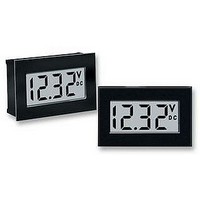DMC-20LCD-1-9-C Murata Power Solutions Inc, DMC-20LCD-1-9-C Datasheet - Page 3

DMC-20LCD-1-9-C
Manufacturer Part Number
DMC-20LCD-1-9-C
Description
DPM, LCD, 3.5DIGIT, 9V
Manufacturer
Murata Power Solutions Inc
Datasheet
1.DMC-20LCD-1-9-C.pdf
(6 pages)
Specifications of DMC-20LCD-1-9-C
Supply Voltage Range
7.5V To 14V
No. Of Digits / Alpha
3.5
Display Size
46.38mm X 32.51mm
Panel Cutout Height
21.3mm
Panel Cutout Width
33.9mm
Operating Temperature Range
0°C To +60°C
Svhc
No SVHC
Lead Free Status / RoHS Status
Lead free / RoHS Compliant
4. BACKLIGHT (Pin 9) Function: Grounding pin 9 (i.e. connecting it to
www.cd4power.com
5. Low Battery Annunciator: The “B” annunciator in the upper left-hand
6. Gain Adjust: There is a gain-adjust potentiometer on the back of each
7. Soldering Methods: All models in the DMS-20LCD Series easily
DMS-20LCD Series
point location pins should be left open. For 5V-powered models, the
decimal location pins are TTL compatible and may be hard wired as
described above or driven with 5V TTL logic gates.
pin 3) turns on the backlighting LED’s. For non-backlit models, pin 9
has no internal connection. All backlit models include internal current-
limiting resistors. With nominal +5V or 9V supplies, backlit devices
typically draw 35mA of supply current. The current drawn by the back-
light (and therefore the current drawn by the meter) can be reduced by
installing a 1/4 Watt resistor between pins 3 and 9. The brightness of
the meter will be reduced proportionately.
9V-powered backlit models function with supply voltages up to +14V,
however, activating the backlight with voltages greater than 9.2V can
damage the meter. Therefore, a 1/4 Watt series resistor must be
installed between pins 3 and 9 in these situations. The value of the
series resistor is determined using the following formula:
corner of the display turns on when the supply voltage for 5V-powered
models falls below approximately +3.7V, or when the supply voltage for
9V-powered models falls below approximately 7.2V. However, the low-
battery annunciator’s turn-on threshold can vary significantly from unit-
to-unit: as low as 2.7V for 5V-powered meters, and as low as 5.4V for
9V-powered models. Applications that use the LOW BAT annunciator
must be fully tested by the user, using a combination of low supply volt-
ages and the input signal’s minimum and maximum levels, to ensure
that all display readings are valid as long as the LOW BAT annunciator
remains off.
meter. It has approximately ±50 counts (±2.5%) range of adjustment.
Since these devices essentially have no zero/offset errors, a gain
adjustment is effectively an overall accuracy adjustment. Though they
may be performed at any point (except zero), accuracy adjustments
are most effective when performed with higher level input signals. The
circuit shown in Figure 9 provides ±10% range of adjustment.
withstand most common wave soldering operations. We recommend,
however, that you evaluate the effects your particular soldering tech-
niques may have on the meter’s plastic case and high-precision electri-
cal performance. We recommend the use of water-soluble solders and
thorough cleaning procedures.
R
Example: If +BATTERY (pin 1 with respect to pin 3) is +12.6V,
R
R
Series
Series
Series
=
=
= 97 Ohms
+12.6 – 9.2V
+BATTERY – 9.2V
0.035
0.035
Ohms
Ohms
3 ½ D I G I T , L C D D I S P L A Y D I G I T A L P A N E L V O L T M E T E R S
APPLICATIONS
DMS-20LCD meters are available in either 5V-powered or 9V-powered
models. 9V devices operate directly from 7.5V to 14V supplies (usually
batteries) without the need for external voltage regulators. 9V devices,
however, can not be used to measure voltages referenced to the negative
battery terminal (pin 3) because the minus input to the meter (pin 12, (–)
INPUT LO) must always be at least 1.5V above pin 3. 9V-powered meters
can only be used to make differential and not single-ended measurements.
5V-powered devices operate from any well-regulated +5V supply and will
accurately measure voltages both above and below pin 3 (5V RETURN) in
either single-ended or differential configurations.
1. Single-Ended Input Configurations: True single-ended measure-
8. Suggested Mating Connectors:
ments can only be made with 5V-powered meters. The circuit of Figure
2 avoids problems normally associated with ground-loop currents.
Separate ground runs should be used for 5V RETURN (pin 3) and (–)
INPUT LO (pin 12).
Panel mounted:
Connector housing
Terminal type
Crimping tool
Wire size
Insulation diameter
Stripping length
Board mounted:
Socket DATEL P/N 39-2359625
120 VAC
+
–
V
IN
AC to DC Converter
UPA-5/500
DATEL
Figure 2. Single-Ended Input Configuration
(–) IN LO
(+) IN HI
D I G I T A L P A N E L M E T E R S
11
12
+5V SUP
(5V-Powered Models)
1
DMS-20LCD-1-5
DATEL P/N 39-2079400
DATEL P/N 39-2099090
DATEL P/N 39-2099000
22 to 26 AWG
0.062” (1.57mm) maximum
0.100 to 0.125” (2.54 to 3.17mm)
6
MPM_DMS-20LCD_E00
DP1
3
5V RET
8
REF OUT
7
REF IN
Page 3 of 6















